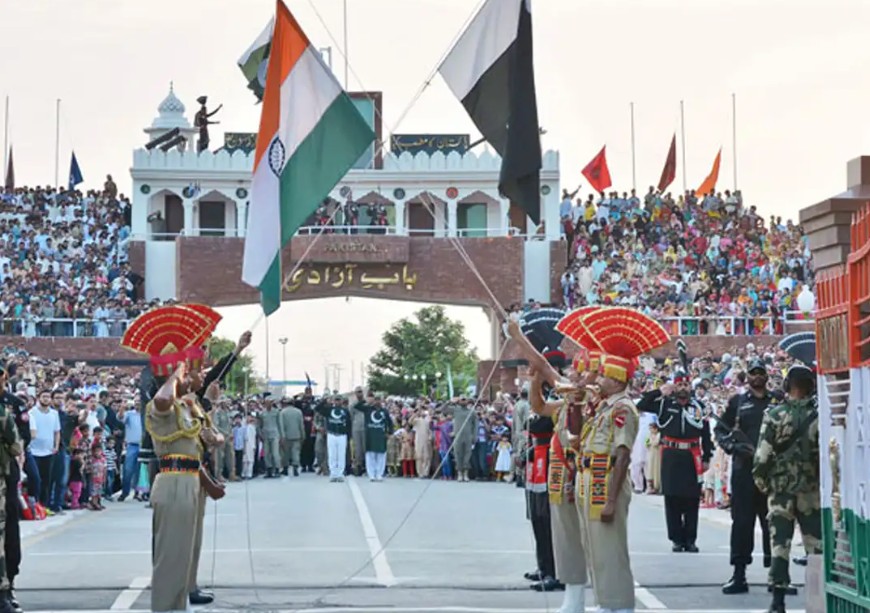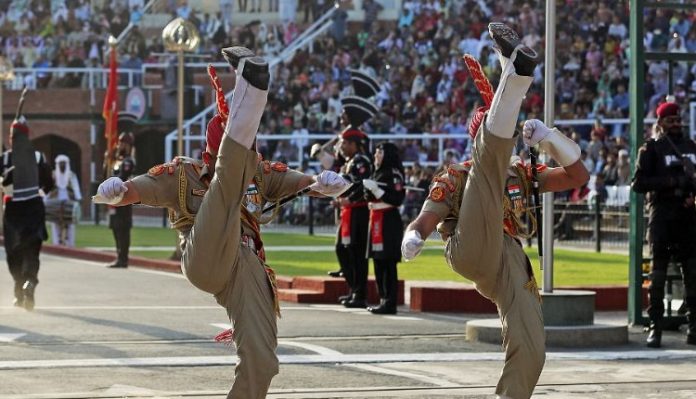Every evening, as the sun dips below the horizon, a peculiar spectacle unfolds at the Wagah-Attari border, the sole road crossing between India and Pakistan in Punjab. For decades, the “Beating Retreat” ceremony, a synchronized flag-lowering ritual performed by the Border Security Force (BSF) and Pakistan Rangers, has drawn thousands of spectators, eager to witness what has evolved into a highly theatrical display of nationalistic fervor. Yet, beneath the veneer of pomp and pageantry, a growing chorus of voices, spanning the entire ideological spectrum from the staunch right-wing to fervent liberals and respected retired military officers, has begun to question the very essence of this daily performance, increasingly labeling it an “obscenity” that has long outlived any constructive purpose.
The ceremony itself is a fascinating, if aggressive, ballet. Soldiers on both sides, adorned in their distinctive uniforms, engage in exaggerated high-kicks, chest-thumping, and synchronized stomps, often accompanied by aggressive glares and shouted patriotic slogans. The air is thick with competitive chants from the respective galleries, creating an atmosphere akin to a gladiatorial arena.
The dramatic lowering of the flags, sometimes with a symbolic handshake (though even this gesture has been suspended recently amid heightened tensions, as was observed on May 20, 2025, following Operation Sindoor), culminates the daily ritual. While undoubtedly a massive tourist attraction and a source of patriotic adrenaline for many, critics argue that this performance, far from fostering dignity or respect, actively perpetuates animosity and trivializes the grave realities of a heavily militarized border.
The criticisms stem from fundamentally different, yet convergent, perspectives. For a segment of the right-wing, the Wagah-Attari parade is an affront to India’s stature. They argue that engaging in such theatrical “peacocking” with Pakistan, a nation they perceive as a constant source of cross-border terrorism and destabilization, demeans India’s military professionalism and national pride.
As some commentators have vociferously expressed, matching Pakistan’s “theatrical aggression lunge for lunge” makes India appear as an equal in a performative absurdity, rather than a dignified, superior regional power. They contend that India’s strength should be projected through quiet resolve, strategic deterrence, and economic might, not through a daily circus that appears to validate a tit-for-tat rivalry. For these critics, the ceremony is not a display of strength, but a “clownery” that cheapens the solemnity of national symbols and the sacrifices of armed forces personnel.

Conversely, liberals view the ceremony as a dangerous perpetuation of jingoism and performative hatred. They lament that thousands of spectators are fed a daily dose of “performative animosity disguised as patriotism,” fueling an exaggerated sense of rivalry rather than fostering any glimmer of peace or understanding. For those who champion reconciliation and people-to-people contact, the aggressive posturing at Wagah-Attari serves as a constant reminder of the bitter partition and the unresolved conflicts, locking the collective psyche of both nations into a cycle of mutual suspicion.
They argue that such a display inhibits the development of mature bilateral relations, preventing any genuine efforts towards de-escalation and cooperation. The sheer emotional intensity of the crowds, egged on by the aggressive drills, is seen as counterproductive to building bridges or even acknowledging a shared cultural heritage.
Perhaps the most damning indictment comes from retired military officers and strategic experts, individuals who have dedicated their lives to the solemn duty of national defense. Many veterans express deep discomfort with the “unseemly dance” and “aggressive staring match” that characterizes the parade. Lieutenant General Kanwal Jeet Singh Dhillon (retired) famously remarked that this “nautanki must stop” and that it is “not a military parade” but a “solemn ceremony” being degraded.
Colonel Dr. Anil Athale (retired) termed it a “mindless display of jingoism,” questioning how such theatrical aggression befits a professional fighting force. Their primary concern is the perceived indignity and un-military-like nature of the show. True military might, they contend, lies in discipline, silent professionalism, and strategic deterrence, not in exaggerated high-kicks and chest-thumping meant for public amusement. They feel that it reduces highly trained soldiers, who undergo grueling training for actual defense, to “peacocking in the extreme,” an embarrassment to the armed forces. For these seasoned professionals, the resources and energy expended on this daily performance could be better utilized in optimizing genuine border security and military readiness.
The Wagah-Attari ceremony, initiated in 1959, began as a simple, dignified flag-lowering ritual, drawing from British military traditions. Over the decades, however, it morphed into the elaborate, almost surreal spectacle it is today. Its evolution mirrors the complex and often fraught relationship between India and Pakistan. While it has become an undeniable tourist attraction, drawing significant crowds and supporting local businesses, critics argue that this economic benefit cannot outweigh the profound negative psychological impact it has on the collective consciousness of both nations. The tragic essence of the border, which witnessed the “ujaada” – the mass displacement and brutal violence of partition – is often lost in this boisterous celebration of rivalry. The Partition Museum in Amritsar stands as a stark contrast, offering a somber, poignant narrative of shared history and loss, while the Wagah-Attari border, just kilometers away, projects an image of performative animosity.
A mature nation, many argue, should be capable of expressing its patriotism and national pride through more dignified and constructive avenues. The alternative to this daily “obscenity” need not be a cessation of all border ceremonies. Instead, a more solemn, subdued flag-lowering ritual, devoid of the theatrical aggression, could be adopted. Such a ceremony would reflect the professionalism of the armed forces without perpetuating animosity. It could be a moment of quiet respect for national symbols, perhaps even incorporating elements that highlight the shared heritage of the Punjabi people on both sides of the divide, rather than focusing on the political divide.


